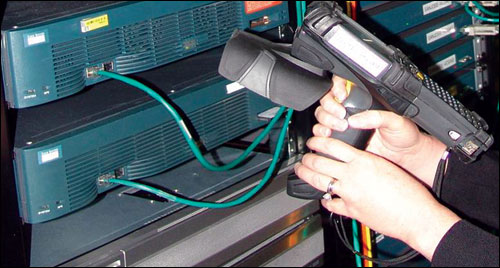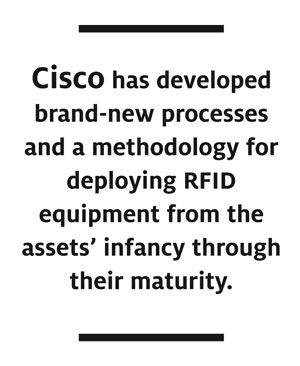Jun 01, 2012Cisco Systems didn't get to be the world's largest networking firm by ignoring technologies that could help it operate smarter and more efficiently. So it's not surprising that the San Jose, Calif.-based firm turned to radio frequency identification when it needed a better way to manage and safeguard one million-plus servers, network gear and other fixed IT assets at 70 U.S. data centers and research-and-development labs.
Yet, the networking giant chose to approach implementation from a business angle, considering people, policy and business processes before researching RFID technologies and vendors and defining an enterprisewide technical solution.
Cisco's Fixed Assets Lifecycle RFID project got under way in January 2010, when the company's senior executives reached a strategic decision to create an improved approach to asset tracking and management. "We wanted to be able, in a very time-effective manner, to do an inventory of our internal fixed assets networking gear," says Maryanne Flynn, Cisco's director of operations, who was selected to co-manage the initiative with Ted Baumuller, the firm's director of IT, marketing and Cisco.com. "We had been using bar codes, but they are a little bit more difficult to leverage because you need to have a line of sight to the bar-code reader." Direct, visible communication isn't always possible in a data center where equipment racks, cables and people often get in the way.
After the executives green-lighted the project, a cross-functional steering committee was formed to represent the interests of the organization's various business and technology areas, including finance, IT, operations and R&D. "We started by looking at our internal policies and processes," Flynn says. "We wanted to find out from our stakeholders—the people who manage these assets on a daily basis—what were some of the pieces of the process that didn't work for them."
As one set of planners tackled stakeholder concerns, another team began researching and interviewing leading RFID systems integrators, hardware and software vendors, using market knowledge and insights gleaned from RFID Journal articles and webinars. "We thought passive RFID would be a much more cost-effective and highly efficient way for us to track and audit our inventory of networking gear," Flynn explains.
A 15-member evaluation committee developed and reviewed requests for information as well as proposals, oral presentations and solution demonstrations from roughly a dozen RFID providers. The team selected RFID Global Solution as its systems integrator. "The choice of our RFID partner was really based on the fact that they had a good understanding of the business process behind the technology," Flynn states. "It wasn't just about getting good read rates."
Deployment Under Way
In November 2010, with its technology planning complete, Cisco began deploying its RFID asset-tracking solution at nine U.S. R&D labs and data centers, in a six-month controlled release field trial. The test implementation was designed to help engineers and business experts evaluate the system's accuracy and functionality. The trial would also provide meaningful insight on the deployment process' efficiency and effectiveness, the receptivity of Cisco's lab engineers to a new business process and answers to what change-management activities would be necessary to further promote adoption. Another goal was to gather baseline and post-install metrics on the accuracy and labor time involved in IT asset-inventory management.
Flynn reports that project managers learned a number of lessons from the trial deployment, such as the need to have total consistency in product-naming conventions for both asset types and data fields, as well as the value of setting portal and tag configurations that register the best possible read rates. Other insights helped improve equipment ordering, inventory stock-level optimization, and training and support requirements.
By completion of the test phase, RFID equipment had been installed at entry and exit doorways and inside interior hallways at more than 35 data centers and R&D labs, primarily in the San Jose, Dallas and Research Triangle Park, N.C., metro areas. "By the end of July, we will have outfitted about 70 internal data centers in the U.S. with this RFID equipment," Flynn says. "We will eventually deploy in other countries, but the plan for that hasn't yet been solidified."
The final system has been rolled out slowly. "We wanted to make sure things worked before we deployed them en masse," Flynn says. "The implementation approach we took was to outfit 10 sites at a time, and make sure the people who work at the data centers really understand the technology before we go on to the next site."
Three primary business processes are affected by the Fixed Assets Lifecycle project: equipment receiving, inventory management and asset sharing. Cisco has developed brand-new processes and a methodology for deploying RFID equipment from the assets' infancy through their maturity, which enables greater visibility and control of the assets, as well as sharing and reuse, cutting capital expenditures.
When a purchase order for a new piece of equipment is created in Cisco's financial-management application, information about the incoming asset is automatically transmitted to RFID Global Solution's Visi-Trac application. "That information consists of things like who bought the asset, when it was purchased, the manufacturer it was purchased from, and the make, model number and location it is to be shipped to—it includes all kinds of rich information about the asset," Flynn says.
As soon as the equipment arrives at Cisco's central receiving facility, it is tagged, and employees at the facility associate the tag's ID number with the asset in Visi-Trac. That information is then automatically forwarded to Cisco's enterprise asset-management database, Tivoli Asset Management for IT software, so asset databases in the data centers are synchronized with the asset-management database at corporate headquarters.
After the asset arrives at a location, its tag is automatically read as the object passes through a portal. Employees also can use a handheld reader or enter a seven-digit human-readable code into the Visi-Trac system. If, instead of being received by Cisco's central receiving facility, an item is shipped directly to a location, the group that ordered the asset tags the item and registers its location in the application. If no one enters a tag ID and location into the system within a specified period of time, the system reminds the person responsible for that asset to do so.
Besides automatically tracking object movements, the system allows users to create specific permissions and receive alerts. A lab manager might indicate, for instance, that a particular piece of equipment is not permitted to leave the facility. Should the tagged item turn up at an exit, the system would immediately notify the manager.
Asset availability information is now readily accessible to Cisco data center and R&D lab managers, allowing equipment to be repurposed and shared between engineering teams.
Exceeding Expectations
The Fixed Assets Lifecycle RFID project has more than lived up to its designers' expectations, Flynn says, noting that Cisco already has observed significant improvements in inventory accuracy, an increased ability to find assets on the first pass and a faster cycle count during audits. Prior to deploying RFID, when conducting a first-pass audit on existing assets in one of the company's labs, 45 percent of expected assets were discovered on the first pass, while the remaining assets had to be found manually during an inventory process that could take several weeks, she says. With the RFID system in place, more than 98 percent of expected assets were found on the first pass with RFID handheld readers—a 118 percent improvement—and the remaining 2 percent were discovered shortly thereafter.
The system has also reduced the audit cycle count for a typical-size lab from more than one week to less than two hours—a 95 percent improvement in the time it takes to comply with and supply reports for mandatory audits.
Flynn credits the project's success to careful planning and testing, as well as ensuring the final system fully meets real-world business needs. She believes that end-user involvement is critical to the success of almost any enterprise RFID initiative. "Really make sure you're engaging with the people you're trying to help," she says. "Involve them in the process design and process solutions before you foist the technology on them."


